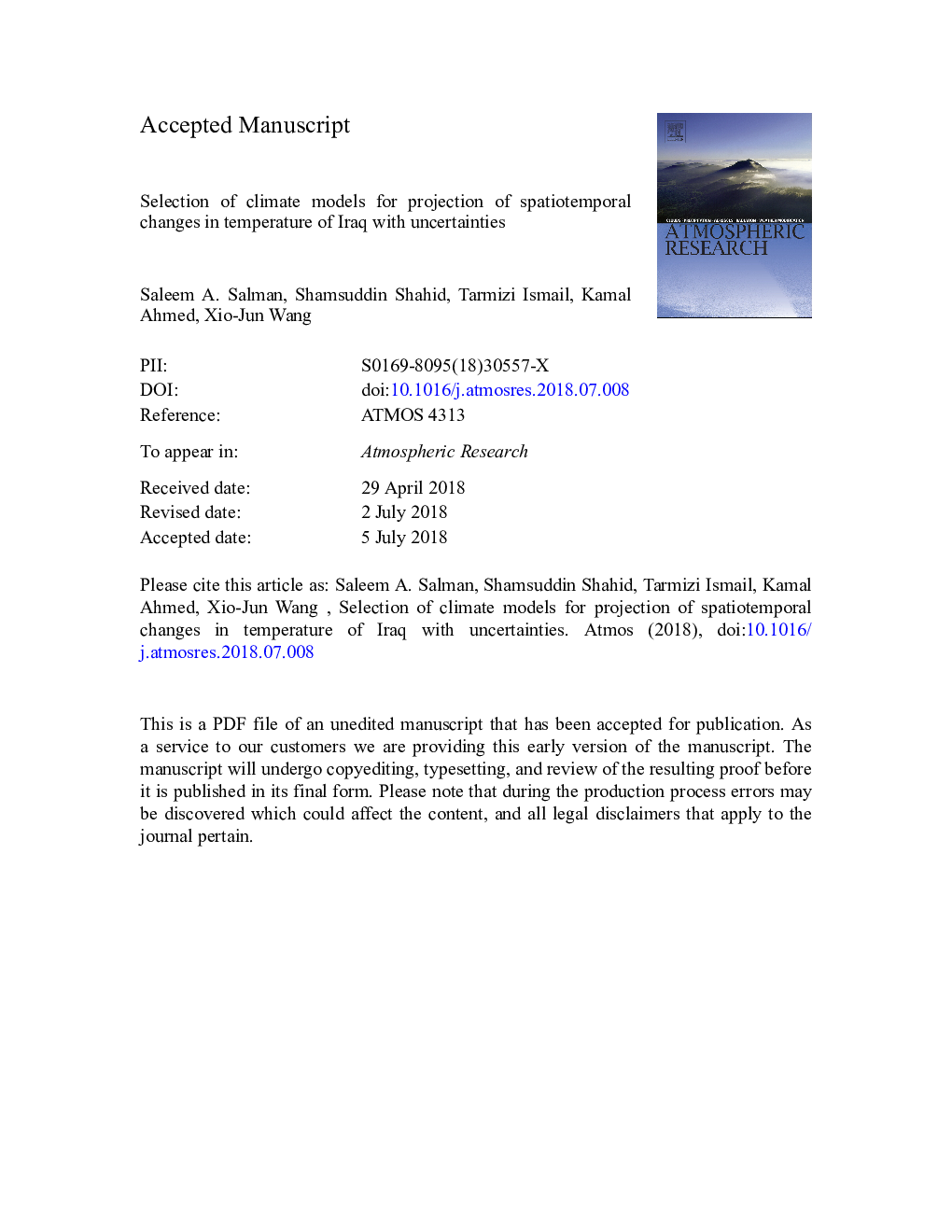| کد مقاله | کد نشریه | سال انتشار | مقاله انگلیسی | نسخه تمام متن |
|---|---|---|---|---|
| 8864554 | 1620468 | 2018 | 36 صفحه PDF | دانلود رایگان |
عنوان انگلیسی مقاله ISI
Selection of climate models for projection of spatiotemporal changes in temperature of Iraq with uncertainties
ترجمه فارسی عنوان
انتخاب مدل های آب و هوایی برای پیش بینی تغییرات زمانی و زمانی در دمای عراق با عدم اطمینان
دانلود مقاله + سفارش ترجمه
دانلود مقاله ISI انگلیسی
رایگان برای ایرانیان
کلمات کلیدی
موضوعات مرتبط
مهندسی و علوم پایه
علوم زمین و سیارات
علم هواشناسی
چکیده انگلیسی
A hybrid approach by combining the past performance and the envelope methods has been proposed for the selection of an ensemble of general circulation models (GCMs) of Couple Model Intercomparison phase 5 (CMIP5) for the projection of spatiotemporal changes in annual and seasonal temperatures of Iraq for four representative concentration pathways (RCP) scenarios. A filter known as Symmetrical Uncertainty (SU) was used to rank the GCMs considering their ability to simulate monthly average of daily maximum and minimum temperature for the historical period (1961-2005). The highest rank GCMs that represents the widest range of projection was then selected for the projection of temperature through statistical downscaling. A linear bias correction approach was used for the downscaling of temperature, a random forest regression was used to generate multi-model ensemble (MME) mean of projections and a quantile regression (QR) was used to assess the trends in projections at 95% level of confidence. Four GCMs namely, HadGEM2-AO, HadGEM2-ES, MIROC5 and MIROC-ESM were found most suitable for projection of temperature of Iraq. Ensemble mean of the selected GCMs revealed increases in minimum temperatures in the range of 1.5-2.4â¯Â°C, 1.6-3.6â¯Â°C, 1.2-4.2â¯Â°C, and 1.3-6.2â¯Â°C and maximum temperatures in the range of 1.7-2.9â¯Â°C, 1.8-4.4â¯Â°C, 1.5-4.9â¯Â°C, and 1.7-6.8â¯Â°C under RCP2.6, RCP4.5, RCP6.0 and RCP8.5 scenarios, respectively during 2070-2099. Higher increases in temperatures were projected in the north and northeast of Iraq where the average temperature is usually low, which indicates that spatial distribution of temperature would be more homogeneous in future compared to base years. The maximum temperature was found to increase more in winter while the minimum in summer. The quantile regression revealed that average summer maximum temperature may reach almost 50â¯Â°C, while the sub-zero temperature will gradually become rare during winter.
ناشر
Database: Elsevier - ScienceDirect (ساینس دایرکت)
Journal: Atmospheric Research - Volume 213, 15 November 2018, Pages 509-522
Journal: Atmospheric Research - Volume 213, 15 November 2018, Pages 509-522
نویسندگان
Saleem A. Salman, Shamsuddin Shahid, Tarmizi Ismail, Kamal Ahmed, Xiao-Jun Wang,
